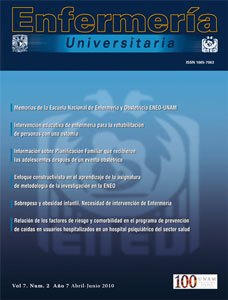Family Planning Information on receiving the teenagers after an obstetric event.
Main Article Content
Abstract
Introductión: Information about Family Planning is geared toward teenagers reproductive health, exercising the right to decide freely, responsibly and informed on the number and spacing of their children.
Objective: To identify the Family Planning information received after an event teenagers obstetric nurses, services and Ginecobstricia Tococirugía.
Methodology: Descriptive study, based on the model of Dorothy E. Johnson, involved 30 teenagers from 15 to 19 years of age treated at the Hospital General de Coyuca de Catalán, Guerrero. The data were collected using a structured instrument of 20 closed questions, validated with Cronbach alpha of 0.87.
Results: 70% of teens agreed more verbal information and demonstration, 26% selected the Intrauterine Device, 16.7% preferred the condom decision as a couple, 13% decided to use injectable progestin, a progestin with estrogen 10%, An association was found between age and educational level which allowed the acceptance of information and choice of contraceptive methods.
Discussion: According to Millán cultural differences, education and other factors greatly affect the ability of understanding of users in Family Planning. Conclusion: The information provided by nurses in the Obstetrics and services Tococirugía teenagers influenced the decisions they made.
Publication Facts
Reviewer profiles N/A
Author statements
- Academic society
- N/A
- Publisher
- Universidad Nacional Autónoma de México
Article Details
Dimensions citation
MÉTRICAS

This work is licensed under a Creative Commons Attribution-NonCommercial-NoDerivatives 4.0 International License.
Enfermería Universitaria by Universidad Nacional Autónoma de México it is distributed under the License Creative Commons Attribution - NonCommercial - NoDerivatives 4.0 International
Accepted and published articles become open-access under the terms of the Creative Commons CC BY-NC-ND 4.0 license, which authorizes the reproduction and sharing without commercial purposes, provided the corresponding acknowledgments to their authors. Authors are allowed to manage a self-archive copy of the article’s published version so that they can open-access it in their personal or institutional web pages, and/or any other broad-diffusion space.


